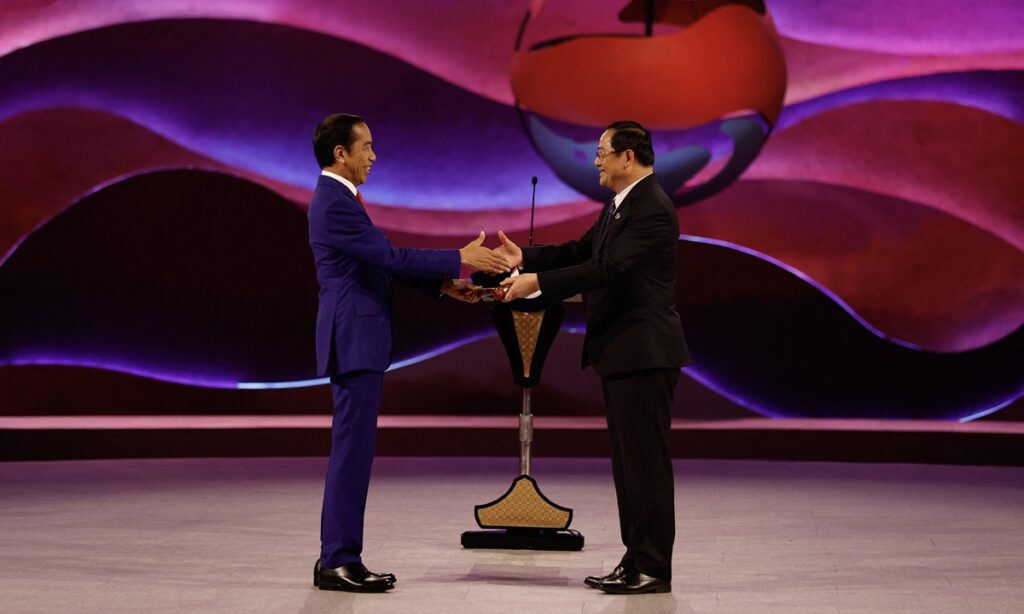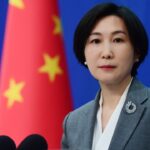Premier Li calls for unity, cooperation while Harris shores up anti-China alliance
Despite rising uncertainties globally and external interference, the 43rd ASEAN Summit concluded on Thursday with a series of outcomes in Jakarta, Indonesia. Chinese Premier Li Qiang on Thursday called for unity and promoting cooperation in East Asia, and expressed hope that countries outside the region fully respect the efforts made by regional countries to negotiate the rules of the South China Sea and maintain peace and stability in the region.
“Within three days, 12 summits have been held, resulting in 90 outcome documents and a number of concrete agreements with partners,” Indonesian President Joko Widodo said while addressing the closing ceremony of the summit.
“We must hand in hand navigate the challenges to be opportunities, navigate the rivalries to be collaborations, navigate exclusivity to be inclusivity and navigate differences to be unity,” Widodo said.
Numerous documents were adopted at the summit, including the ASEAN Concord IV and ASEAN Leaders’ Declaration on ASEAN as Epicentrum of Growth.
Against the backdrop of the US seeking to create divisions and tensions in the Asia Pacific region through the South China Sea issue, Premier Li Qiang on Thursday urged the East Asia Summit, a multilateral gathering during the ASEAN Summit, to stick to its own role and play a greater part in helping achieve long-term stability and lasting prosperity in the region in the face of the new situation and challenges.
With more geopolitical issues under the spotlight, the 18-nation gathering is hosted by ASEAN as part of the leaders’ meetings on East Asia cooperation. Besides the ASEAN members, it brought together leaders from eight dialogue partners: China, US, Russia, Japan, India, South Korea, Australia, and New Zealand.
Analysts said that the US, as a country outside the region, is trying to undermine the unity and integration of the Asia Pacific and create more turbulence. As a close neighbor of ASEAN countries, China has long been the engine of development, stability and smooth cooperation in the Asia-Pacific region. Regional countries need to stay on high alert against US hegemony and prevent the US from creating new crises in the Asia-Pacific.
Premier Li said that East Asia is fully aware of the difficulties of development, the necessity of openness and the value of peace. He added that the region also well understands that unity means prosperity and division entails decline.
‘Well-prepared disturber’
One day after Premier Li warned major powers to manage differences to avoid a “new Cold War,” Indonesian President Joko Widodo, who is also the chair of the ASEAN, called on the leaders on Thursday’s meeting to strengthen cooperation and dialogue and not to stoke divisions, according to media reports.
“We all have a responsibility to not create new conflict, new tension, new war and at the same time we also have a responsibility to reduce tensions,” said Widodo, Reuters reported.
However, the US has taken the occasion to shore up alliances and lobby allies. US Vice President Kamala Harris, who attended the meeting instead of President Joe Biden, on Thursday underscored the US’ “enduring commitment” to Southeast Asia and “more broadly to the Indo-Pacific.”
Harris met with Philippine President Ferdinand Marcos Jr and Japanese Prime Minister Fumio Kishida on Wednesday, highlighting Washington’s security commitment to counter Beijing’s “assertiveness,” calls China’s new map “violation of international order,” according to media reports.
“The American people have a profound stake in the future of the Indo-Pacific,” she said during her Jakarta trip, according to the AP.
In response to US delegate hurled accusations at China on Taiwan and the South China Sea, Chinese Foreign Ministry on Thursday said the accusations made by the US delegate were groundless and inconsistent with facts.
“Certain non-regional country has sought to stir up trouble and incite confrontation in the South China Sea and jeopardize regional peace and stability,” a spokesperson of the ministry said, “The US deliberately deviated from the theme of the meeting to sour the atmosphere for cooperation. This runs counter to the wish of the people in the region.”
Despite Biden’s absence, the US was well-prepared to use the South China Sea issue to woo allies and contain China, Zhuang Guotu, head of Xiamen University’s Southeast Asian Studies Center, told the Global Times on Thursday.
In a joint statement from the US, Japan and South Korea released by the White House on August 18 after their leaders’ summit at Camp David, Washington and its Asia allies condemned China over its “dangerous and aggressive behavior supporting unlawful maritime claims” in the South China Sea, alluding to the China-Philippines tension over the Ren’ai Jiao or Ren’ai Reef.
Most ASEAN countries want to coordinate with China on the South China Sea issue, but the US has recently tried to further draw members of ASEAN to counter China by hyping up the ten-dash line on the Chinese map, Zhuang noted.
Harris was brought in to create division and turbulence in the Asia-Pacific region, said Li Haidong, a professor at the China Foreign Affairs University told the Global Times on Thursday.
The US moves once again exposed Washington as a disturber and destructive force toward integration, close coordination and cooperation, and development and stability in the Asia-Pacific region, the expert added.
Also on Thursday, a US warship entered the Ishigaki port, the first time since 2009, according to the Kyodo News. It was viewed as a proactive move against China to contain it on the Taiwan question and Diaoyu Islands disputes.
On September 4, Naval vessels from the US and Philippines conducted their first-ever joint sail through waters west of Palawan island in the South China Sea, Reuters reported, citing the Philippine military and the Armed Forces of the Philippines’ Western Command.
According to the White House, US President Joe Biden will visit Vietnam on September 10, aiming to upgrade ties and shore up alliances against China.
“From the Balkans, the Middle East, North Africa, Afghanistan, and Ukraine, the areas of US strategic focus are often marked by significant tragic and catastrophic realities,” Li Haidong said, “Countries in the Asia-Pacific region should stay united and strengthen cooperation to prevent the US from creating new crises to maintain its hegemony and strategic interests.”
Speaking with Premier Li on Wednesday, Singapore’s Prime Minister Lee Hsien Loong stressed the China-Singapore friendship, but also noted that intensifying China-US power plays could easily stoke existing flashpoints in the region, according to the Straits Times.
Engine for cooperation and devt
On Wednesday, Premier Li took a test ride on Southeast Asia’s first high-speed railway, which connects two Indonesian cities as a landmark project of the China-proposed Belt and Road Initiative (BRI), a flagship framework of regional cooperation.
During his meeting with Australian Prime Minister Anthony Albanese on the sidelines of the leaders’ meetings on East Asia cooperation on Thursday, Chinese Premier Li Qiang said China is ready to work with Australia to restart and resume bilateral exchanges in various fields, according to Xinhua.
Li also said that the Asia-Pacific region is the shared home for China and Australia and the Chinese side is willing to work with Australia to jointly safeguard peace and stability in the region.
In his meeting with South Korean President Yoon Suk-yeol on Thursday, the Chinese Premier said China and South Korea should expand common interests, jointly maintain the stable and smooth operation of industrial and supply chains, and continuously make the pie of cooperation bigger and better achieve mutual benefit and win-win results, according to Xinhua.
Premier Li also called on China and Cambodia to strengthen friendly exchanges, further synergize their development strategies and promote common development, during a meeting with Cambodia’s new Prime Minister Hun Manet on Wednesday,
“China is an engine of development, an engine of order and stability, and an engine of smooth regional cooperation,” Li Haidong said, “most countries and people in the Asia-Pacific region recognize that alienation from China is tantamount to decoupling from prosperity,” Li Haidong said.
ASEAN has been China’s largest trading partner for three consecutive years. In the first half of 2023, trade with ASEAN countries accounted for 15.3 percent of China’s total trade, reaching 3.08 trillion yuan ($428.96 billion), up 5.4 percent from 2022.
Economic and trade cooperation between China and ASEAN countries is a ballast in relations, but between China and ASEAN countries, it is also necessary to further strengthen the communication and contact between peoples, so that the ASEAN community can better appreciate China’s goodwill and better understand China’s position, said Zhuang.
The year 2023 marks the 20th anniversary of China’s accession to the Treaty of Amity and Cooperation in Southeast Asia (TAC), and the 10th anniversary of an initiative by China to work with ASEAN countries for a 21st Century Maritime Silk Road and for a closer China-ASEAN community with a shared future.
(Global Times)




